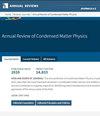Fractional Statistics
IF 30.7
1区 物理与天体物理
Q1 PHYSICS, CONDENSED MATTER
Annual Review of Condensed Matter Physics
Pub Date : 2024-03-11
DOI:10.1146/annurev-conmatphys-040423-014045
引用次数: 0
Abstract
The quantum-mechanical description of assemblies of particles whose motion is confined to two (or one) spatial dimensions offers many possibilities that are distinct from bosons and fermions. We call such particles anyons. The simplest anyons are parameterized by an angular phase parameter θ. θ = 0, π correspond to bosons and fermions, respectively; at intermediate values, we say that we have fractional statistics. In two dimensions, θ describes the phase acquired by the wave function as two anyons wind around one another counterclockwise. It generates a shift in the allowed values for the relative angular momentum. Composites of localized electric charge and magnetic flux associated with an abelian U(1) gauge group realize this behavior. More complex charge-flux constructions can involve nonabelian and product groups acting on a spectrum of allowed charges and fluxes, giving rise to nonabelian and mutual statistics. Interchanges of nonabelian anyons implement unitary transformations of the wave function within an emergent space of internal states. Anyons of all kinds are described by quantum field theories that include Chern–Simons terms. The crossings of one-dimensional anyons on a ring are unidirectional, such that a fractional phase θ acquired upon interchange gives rise to fractional shifts in the relative momenta between the anyons. The quasiparticle excitations of fractional quantum Hall states have long been predicted to include anyons. Recently, the anyon behavior predicted for quasiparticles in the ν = 1/3 fractional quantum Hall state has been observed in both scattering and interferometric experiments. Excitations within designed systems, notably including superconducting circuits, can exhibit anyon behavior. Such systems are being developed for possible use in quantum information processing.分数统计
量子力学对运动局限于两个(或一个)空间维度的粒子集合体的描述,提供了许多有别于玻色子和费米子的可能性。我们称这种粒子为任子。θ=0、π 分别对应玻色子和费米子;在中间值时,我们说存在分数统计。在二维空间中,θ 描述了两个任意子逆时针绕彼此旋转时波函数所获得的相位。它产生了相对角动量允许值的变化。与非良性 U(1) 轨距群相关的局部电荷和磁通的复合体实现了这种行为。更复杂的电荷-磁通量结构可能涉及作用于允许电荷和磁通量频谱的非阿贝尔群和积群,从而产生非阿贝尔统计量和互统计量。非阿贝尔任子的相互交换在内部态的新兴空间内实现了波函数的单元变换。各种任子都可以用包含切尔-西蒙斯项的量子场论来描述。一维任子在环上的交叉是单向的,因此交换时获得的分数相位θ会引起任子间相对矩的分数移动。长期以来,人们一直预测分数量子霍尔态的准粒子激发包括任子。最近,在散射和干涉测量实验中观察到了ν = 1/3 分数量子霍尔态准粒子的任子行为。设计系统内的激发,特别是包括超导电路在内的系统内的激发,也会表现出任子行为。目前正在开发此类系统,以用于量子信息处理。
本文章由计算机程序翻译,如有差异,请以英文原文为准。
求助全文
约1分钟内获得全文
求助全文
来源期刊

Annual Review of Condensed Matter Physics
PHYSICS, CONDENSED MATTER-
CiteScore
47.40
自引率
0.90%
发文量
27
期刊介绍:
Since its inception in 2010, the Annual Review of Condensed Matter Physics has been chronicling significant advancements in the field and its related subjects. By highlighting recent developments and offering critical evaluations, the journal actively contributes to the ongoing discourse in condensed matter physics. The latest volume of the journal has transitioned from gated access to open access, facilitated by Annual Reviews' Subscribe to Open initiative. Under this program, all articles are now published under a CC BY license, ensuring broader accessibility and dissemination of knowledge.
 求助内容:
求助内容: 应助结果提醒方式:
应助结果提醒方式:


